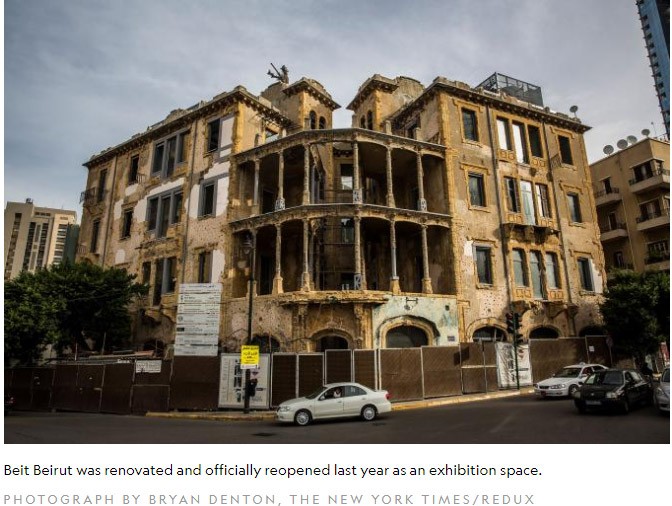Ravaged by war, Beirut’s historic sites are being reimagined
These formerly abandoned landmarks are getting a second life as galleries, restaurants, and cultural centers.
BY ABBY SEWELL
In the mountains above Beirut, a stately Ottoman-era hotel came to life again last autumn after decades of abandonment.
The Grand Hotel Casino Ain Sofar–once a preferred vacation spot for the region’s stars and the site of weddings and lavish parties–was left to looters and the occupying Syrian Army during Lebanon’s civil war, which lasted from 1975 to 1990. It was finally left empty and in disrepair.
But this past fall, hundreds of Lebanese and foreign guests once again flooded the hotel—renovated but still deliberately bearing the scars of its past—this time for weeks of events that included an art exhibition, storytelling nights, and DJ sets. The hotel has once again become the site of weddings and parties.
It’s one of a handful of examples in a growing push in Lebanon toward rehabilitating threatened landmarks, many of them damaged in the war, and re-envisioning them as collective spaces.
Amid the largely privatized post-war reconstruction process, developers and politicians imagined Beirut transforming into a glittering modernist metropolis like Dubai. Many of the city’s historic French Mandate and Ottoman-era buildings were leveled and replaced by high rises.
But as the construction has picked up pace, with cranes hovering over half-finished towers in most of Beirut’s neighborhoods, so has the push to preserve the heritage sites that remain.
“It’s a matter of identity,” says Joana Hammour, one of the organizers of Save Beirut Heritage, an organization formed in 2010 that has pushed to save threatened sites and for legislation that would preserve more. In a country with 18 recognized religious sects and a complicated patchwork of political groups, Hammour says, “We need to have those spaces of collective memory, spaces of gathering, spaces of community, to live together.”
Beit Beirut is one attempt at creating such a space. The imposing yellow building, elegant despite the bullet holes riddling its exterior, occupies a prominent corner in central Beirut on the former demarcation line that separated East and West Beirut during the civil war. Formerly a family home known as the Barakat building, it became a snipers’ perch during the war.

The building was saved from demolition, largely via the advocacy of local architect Mona Hallak. Under the ownership of the Beirut municipality, it was renovated, and officially reopened last year as an exhibition space, although not exactly as the museum of collective memories that Hallak and other preservationists envisioned. With no full-time staff on site, the building is open to the public only during exhibitions and special events, some of them unrelated to Beirut’s history.
Other once-vacant heritage sites have been renovated in recent years and reemerged with a range of uses: as galleries, cultural centers, restaurants, and private residences. But many remain abandoned or under threat.
Sarah Kouzi is one of a group of parents fighting to prevent the planned relocation of Lycee Abdel Kader, a 110-year-old French school in West Beirut, its lush campus one of the few remaining oases of green space in the area.
The school continued to operate throughout the civil war and took in students displaced from other schools closer to the Green Line, Kouzi said, referring to the unofficial border that divided warring factions between east and west Beirut. But now parents fear that with a planned relocation and sale of the property will come demolition of the school.
“It’s not just about the building but about the cultural heritage,” Kouzi explains. “It’s been part of that community for so long, it’s part of collective memories. It’s like another collective memory in Beirut is being destroyed.”
After a campaign to save the site attracted some prominent supporters, Lebanon’s Minister of Culture issued a decree earlier this month declaring the school building to be a heritage site. The move means the building itself should be protected, but does not necessarily prevent the school from being relocated.
Some sites have been saved from demolition by land disputes and ownership changes or by simple inertia, but their future remains unclear.
One of these, an abandoned former cinema along the Green Line in downtown Beirut dubbed the Egg because of its distinctive shape, had an unofficial second life: in the 1990s, it became the site of underground rave parties and art exhibitions. Every rumor of plans to redevelop the site drew massive public pushback. For now the Egg remains, but with the exception of one recent art exhibition, it’s largely abandoned.
Another accidentally preserved structure is arguably the most iconic representation of the civil war’s legacy: the Holiday Inn on the outskirts of Beirut’s downtown. For years the scene of some of the war’s bloodiest battles, it was occupied by one armed group after another. The hulking 26-story building remains riddled with bullet holes and is now occupied by the Lebanese Army.
Tom Young, a British painter who has lived in Lebanon for the past decade, specializes in works dealing with buildings and the memories they contain. His paintings played a prominent part in the reopening of the Grand Sofar hotel. Young is now working on a series of depictions of the Holiday Inn.

“You can be successful by preserving heritage,” she says. “You might not make millions like when you build a tower, but those millions are very short term. They happen now and then they disappear, whereas when you do this kind of action, you have more of a long-term impact. You contribute to your community, and by doing that you get a return from the community.”
Article Source: [nationalgeographic]
You must be logged in to post a comment.